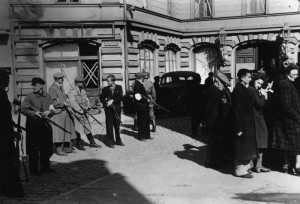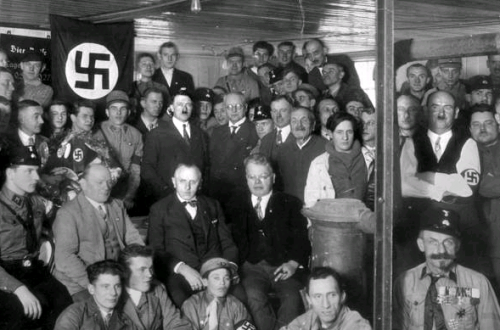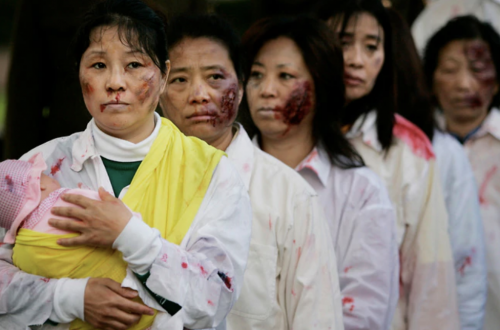Darta Kaleja is in the news today, when her speech against the particular commemoration of the Holocaust on Holocaust Memorial Day was applauded at NUS Conference.
You can see the video here:
Guido Fawkes provides the transcript:
“Before I start I want to make it clear I am not against commemorating the Holocaust. I am against the NUS and the government forgetting and ignoring the mass genocides, and prioritising some lives over others… In my five years of UK education throughout GCSEs and A Levels, not once were the genocides of Tibet, Rwanda, or Zanzibar taught to me and my peers. So please, please vote against this motion, against the one day dedicated purely to atrocities of just one mass genocide, as it suggests that some lives are more important than others. Instead campaign for a day to commemorate all of them.”
Holocaust Memorial Day does, of course, teach about other genocides: including Cambodia, Rwanda, Bosnia and Darfur.
As a woman of Latvian extraction, I would have thought that Darta Kaleja would have an interest in commemorating the Holocaust: an event which took place in her country of origin. (According to her Facebook page, she attended this private school in Latvia before coming to the United Kingdom)
In 1939, Latvia had a Jewish population of 95,600.
According to Wikipedia, it is estimated that 90% of Latvia’s Jews were murdered during the Nazi occupation. Persecution continued when the USSR returned.
Latvia now has a Jewish population of around 6,500.
Latvians participated in the murder of Jews:
[T]he Latvian Arajs Kommando played a leading role in the atrocities committed in the Riga ghetto in conjunction with the Rumbula massacre on 30 November 1941. One of the most notorious members of the group was Herberts Cukurs. After the war, surviving witnesses reported that Cukurs had been present during the ghetto clearance and fired into the mass of Jewish civilians. According to another account Cukurs also participated in the Burning of the Riga synagogues. According to Bernard Press in his book The Murder of the Jews in Latvia, Cukurs burned the synagogue on Stabu Street
At the instigation of the Einsatzgruppe, the Latvian auxiliary police carried out a pogrom against the Jews in Riga. All synagogues were destroyed and 400 Jews were killed. According to Stahlecker’s report, the number of Jews killed in mass executions by Einsatzgruppe A by the end of October 1941 in Riga, Jelgava (Mitau),Liepāja (Libau), Valmiera (Wolmar), and Daugavpils (Dvinsk) totaled 30,025, and by the end of December 1941, 35,238 Latvian Jews had been killed; 2,500 Jews remained in the Riga Ghetto and 950 in the Daugavpils ghetto.
Here is some more information from Wikipedia on the complicity and participation of the Latvian authorities in the Holocaust:
In Liepājathe first mass killing of Jews took place on July 3 and 4, when about 400 people were shot dead, and on July 8 when 300 Jews were killed. The German group of SD and policemen did the shooting, while the members of Latvian Selbstschutz convoyed victims to the killing site.[12]On July 13 the destroying of the large choral synagogue of Liepāja began. The rolls of the Scripture were spread on the Ugunsdzēsēju Square, and the Jews were forced to march across their sacred things, with watchers merrily laughing at the amusing scene. The above operations took place under the direct leadership of Erhard Grauel, commander of theEinsatzgruppe‘s Sonderkommando.
Thereafter Grauel went to Ventspils. The killings were jointly carried out by German Ordnungspolizei and the men of the local Selbstschutz. On July 16-July 18, 300 people were shot dead in the Kaziņu Forest. In July–August the remaining 700 Jews of the town were shot dead, while the Jews of the region were killed in the autumn. The shooting was carried out by German, Latvian and Estonian SD men who had arrived by ship. Soon a poster appeared on the Kuldīga-Ventspils highway, which said that Ventspils was Judenfrei (free of Jews).
In Daugavpils the extermination of Jews was initially commanded by Erich Ehrlinger, chief of Einsatzkommando 1b.[13] By July 11 they had killed about 1150 people. Ehrlinger’s work was continued by Joachim Hamann, who was liable for the killing of 9012 Jews in the city and in southern Latgale. The chief of the local auxiliary police Roberts Blūzmanis had rendered active assistance by ensuring the moving of the Jews to the Grīva ghetto and transporting them to the killing places.
Latvia was also used as an execution ground for German Jews:
At the end of 1941 and the beginning of 1942, Jews deported from Germany, Austria, Czechoslovakia, and other German occupied countries began arriving in Latvia. Some 15,000 “Reich Jews” were settled in several streets of the liquidated “greater Riga ghetto”. Many transports were taken straight from the Riga railroad station to execution sites in the Rumbula and Biķernieki forests near Riga, and elsewhere. In 1942 about 800 Jews from Kaunas Ghetto (in Lithuania) were brought to Riga and some of them participated in the underground organization in the Riga ghetto.
One would have hoped that Darta Kaleja would have more interest in commemorating this aspect of local European history.
You can read more about the Holocaust in Latvia, here.
Members of Latvian Auxiliary Police assemble a group of Jews, Liepāja, July, 1941



